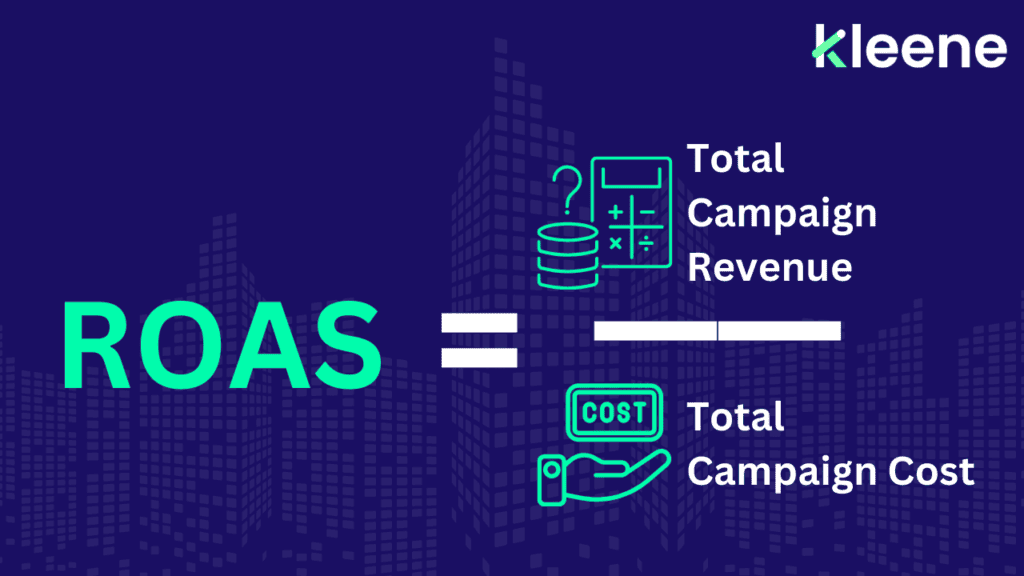7 Powerful Tips on How to Work Out ROAS Accurately
Understanding how to work out ROAS (Return on Advertising Spend) is crucial for any business aiming to optimise its marketing efforts and maximise profitability. In this comprehensive guide, we’ll delve deep into how to work out ROAS, why black box solutions fail, the necessity of full-channel measurement, and the importance of using advanced marketing spend optimisation tools.
What is ROAS?
ROAS stands for Return on Advertising Spend. It measures the revenue generated for every pound spent on advertising. Knowing how to work out ROAS involves understanding how effectively your advertising budget converts into revenue. In this article, we’ll thoroughly explore how to work out ROAS and why it’s essential for making informed marketing decisions.
7 Tips on How to Work Out ROAS Accurately
1. Use the Basic ROAS Formula
To get started with how to work out ROAS, you need to understand the basic formula:

For example, if you spent £500 on an advertising campaign and generated £2000 in revenue, your ROAS would be:
ROAS=£2000/£500=4
This means you earned £4 for every £1 spent on advertising. Mastering how to work out ROAS using this formula is foundational.
2. Avoid Black Box Solutions
One key message in learning how to work out ROAS is that black box solutions—those that offer little transparency into their inner workings—often fail to provide accurate measurements. These solutions may not cater to the unique needs of your business, leading to inaccurate data and poor decision-making. To accurately work out ROAS, you need a tailored tool that offers detailed insights into advertising performance.
3. Implement Full Channel Measurement
Without a comprehensive channel measurement tool, companies struggle to gauge the effectiveness of their brand spending. Full channel measurement enables businesses to track and analyse how each marketing channel performs. This is essential for optimising your marketing budget and ensuring resources are allocated efficiently. Understanding how to work out ROAS from each channel individually helps in strategic budget allocation.
4. Use Advanced Marketing Spend Optimisation Tools
A marketing spend optimisation tool is invaluable for accurately calculating ROAS. These tools do more than just measure the impact of each channel; they use predictive models to forecast how changes in your budget will affect ROAS, Customer Acquisition Cost (CAC), and Lifetime Value (LTV). This allows for more strategic allocation of marketing resources. Knowing how to work out ROAS with predictive insights can enhance your decision-making process.
5. Calculate Break-Even ROAS
One crucial aspect of calculating ROAS is determining the break-even point. The break-even ROAS is the minimum ROAS you need to cover your advertising costs without making a loss. Use the following formula:

For instance, if you spent £1000 on ads and your COGS is £2000, your break-even ROAS would be:
Break-Even ROAS=£1000/£2000=0.5
This means you need to earn at least £0.50 for every £1 spent on advertising to break even.
6. Express ROAS as a Percentage
When working out ROAS, it’s useful to express it as a percentage for a clearer view of its effectiveness. To convert ROAS into a percentage:
ROAS Percentage=(ROAS−1)×100%
7. Consider All Touchpoints with Advanced Tools
To accurately predict or calculate ROAS, use a measuring tool with advanced algorithms that considers all touchpoints, both online and offline. An advanced ROAS measurement tool integrates data from various sources, including social media, search engines, and offline channels, for a holistic view of your advertising performance. Knowing how to work out ROAS with such tools ensures a comprehensive analysis of your marketing efforts.

Conclusion
In summary, knowing how to work out ROAS is vital for effective marketing spend management. Black box solutions often fall short of providing the necessary insights, making a tailored tool essential for accurate measurement. Full-channel measurement is crucial for understanding brand spending, and using marketing spend optimisation tools with predictive capabilities can greatly enhance your strategic decision-making. Accurate ROAS calculation requires a tool that considers all touchpoints, ensuring a clear picture of your advertising effectiveness.
By applying these tips and utilising the right tools, you can optimise your advertising strategy, maximise your return on investment, and make data-driven decisions that propel your business forward.
Next Steps for increasing ROAS
Integrating cutting-edge technological platforms, such as Kleene’s Decision Intelligence Platform, can make it easier for Chief Marketing Officers to implement Marketing Mix Modelling and ensure ROI.
By streamlining the implementation of Marketing Mix Modelling , our platform enables Marketing teams to access deeper insights more efficiently and effortlessly. This efficiency is achieved through:
- Comprehensive Data Integration: Our platform excels in aggregating a wide array of data sources, including sales, marketing, consumer behaviour analytics, finance, and logistics. This extensive integration facilitates a more thorough and accurate analysis.
- Holistic Campaign Analysis: The platform is adept at measuring the impact of both online and offline campaigns, ensuring a comprehensive view of marketing efforts. Enhanced Insights from Comprehensive Data: with the inclusion of diverse data sets, the platform provides richer insights, enabling more informed decision-making
- User-Friendly Interface: Kleene’s platform is designed with user experience in mind, allowing CMOs and their teams to navigate complex data analytics with ease. This simplifies the process of deriving actionable insights from MMM results.
- Exceptional Support and Expertise: Kleene partners with clients to ensure a significant return on investment and effective implementation of the platform, providing unparalleled support and expertise.
Contact a Kleene.ai data expert to learn more about how their Decision Intelligence Platform can help your company get a better ROAS
You may also like:
Return on Ad Spend: 10 Proven Strategies to Maximize
The Ultimate Guide to ROAS Marketing: 7 Powerful Tips to Master ROAS
ROAS Formula: 7 Effective Strategies to Amplify Your Advertising Returns
How to Calculate ROAS in 2024: A Comprehensive Guide to Maximising Your Return on Ad Spend
Frequently Asked Questions
1. How do I work out ROAS for different advertising channels?
To work out ROAS for each advertising channel, use the basic ROAS formula for each channel individually. This involves calculating the revenue generated from each channel and dividing it by the cost of ads for that channel. This approach is essential for understanding how to work out ROAS for different channels and optimising your marketing budget accordingly.
2. How do I work out break-even ROAS?
To work out break-even ROAS, divide the cost of ads by the revenue minus the cost of goods sold (COGS). This calculation helps you determine the minimum ROAS needed to cover your advertising costs and avoid making a loss. Knowing how to work out break-even ROAS is essential for ensuring your campaigns are financially sustainable.
3. What is the best way to work out ROAS as a percentage?
To work out ROAS as a percentage, subtract 1 from your ROAS value and multiply by 100. This gives you a percentage that reflects the return on every pound spent on advertising. For example, a ROAS of 4 converts to a 300% return. Understanding how to work out ROAS as a percentage provides a clearer view of advertising effectiveness.
4. How do I work out ROAS from total purchases and revenue?
To work out ROAS from total purchases and revenue, divide the total revenue generated from purchases by the total cost of ads. This calculation provides an overall ROAS, reflecting how much revenue was earned for each pound spent on advertising. Knowing how to work out ROAS from total purchases helps you assess the effectiveness of your marketing strategies.
5. How do I calculate ROAS for free plus shipping offers?
For free plus shipping offers, include the cost of the promotion in your ROAS calculation. Divide the revenue from sales by the sum of the cost of ads and the promotion costs. This ensures you account for all associated costs when calculating ROAS. Understanding how to work out ROAS for such offers is crucial for accurate measurement.
6. How do I compare ROAS year-over-year (YOY)?
To compare ROAS YOY, subtract last year’s ROAS from this year’s ROAS, divide by last year’s ROAS, and multiply by 100 to get the percentage change. This comparison helps you assess the effectiveness of your advertising strategy over time. Knowing how to work out ROAS YOY allows for evaluating growth and improvements.
7. What tools are best for working out ROAS accurately?
Advanced marketing spend optimisation tools that use predictive models and consider all touchpoints, both online and offline, are best for working out ROAS accurately. These tools provide comprehensive analysis and help in making data-driven decisions for better ROI. Understanding how to work out ROAS with these tools ensures precise and actionable insights.
8. Why is it important to avoid black box solutions for ROAS?
Black box solutions often lack transparency and fail to provide clear insights into advertising performance. For accurate ROAS measurement, you need a tool that offers detailed analytics and allows you to understand the impact of each channel on your revenue. Knowing how to work out ROAS effectively requires avoiding such opaque solutions.
9. How can predictive models enhance ROAS calculation?
Predictive models can forecast the impact of changes in your advertising budget on ROAS, CAC, and LTV. This helps in making informed decisions about budget allocation and optimising your marketing spend for better results. Learning how to work out ROAS with predictive insights provides a strategic advantage.
10. What role does full-channel measurement play in ROAS calculation?
Full-channel measurement allows you
to track and analyse the performance of each marketing channel individually. This comprehensive view is essential for understanding how different channels contribute to your overall ROAS and optimising your advertising strategy. Knowing how to work out ROAS with full-channel measurement helps in achieving a complete picture of your marketing effectiveness.



